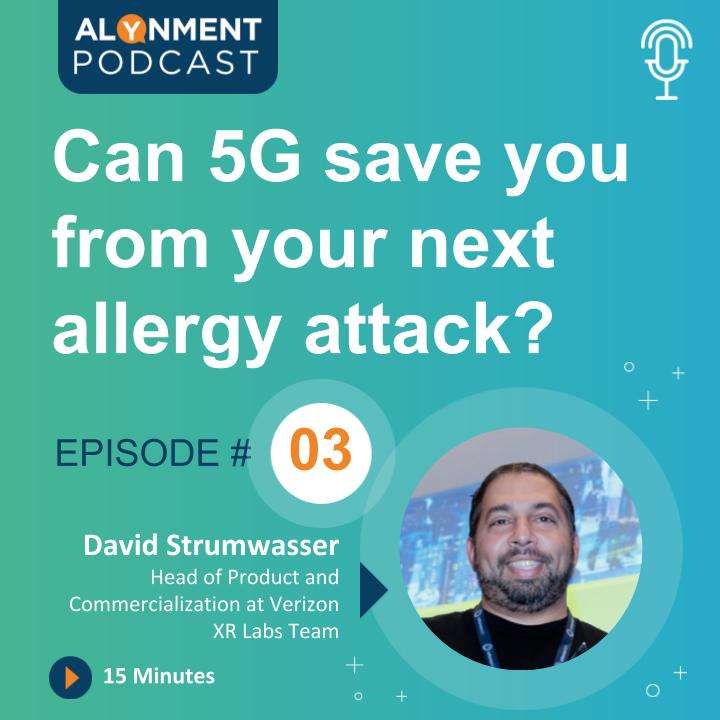5G technology means many things to many people. There are a lot of theories on how it will impact the everyday lives of consumers and businesses. While many experts argue that 5G will revolutionize the way we shop, the skeptics question if it has any real benefits for retailers. Our guest today, David Strumwasser, is an expert in this area and head of product and commercialization at Verizon XR labs. Join us as he decodes the innumerable possibilities that 5G technology, edge computing, and augmented reality hold for us, and we try to connect the dots between technology and business impact in this third episode of our Alynment podcast series.

Ashish: Why don’t you talk to us a little bit about what is XR Labs and what does XR really mean?
David: The organization that I’m a part of, we originally started by developing a streaming platform for developing augmented and virtual reality experiences. Then, as we saw that 5G was coming more to the forefront, and there was going to be this incredible bandwidth available to customers, low latency, the ability to have more users in a given cell sector compared to 4G, we started looking into ways that we can now deliver these high fidelity experiences on mobile devices.
One of the first things we started looking at is, what’s the most critical piece needed for delivering high graphics AR and VR? That was the GPU (Graphics Processing Unit). We started looking for ways that we could offload GPU compute from mobile devices and move it into the network. This led us to some breakthroughs on ways that we could slice the GPU for a scalable architecture, as well as how we can start delivering these AR, VR graphics in applications on lower-powered devices. [Listen to the complete podcast here.]
CONNECTING THE DOTS BETWEEN THE TECHNOLOGY, HOW ENTERPRISES AND CONSUMERS CAN USE IT
Ashish: That sounds pretty cool. If I am an enterprise talking about 5G, there are some industry gaps there. The vendor community, the technology community, the service providers are not aligned. They’re all talking about 5G from a perspective of bandwidth. Can you help me connect the dots between, as an enterprise business person, or as an enterprise CIO, why should I care about 5G or AR and how does it make a difference for me?
David: The first use case that I can give you in the retail space is, one of the demos that we’re showing here at Mobile World Congress. It’s a retail shopping demo where you have different food products that are on the shelf. In today’s world, everyone knows someone that has a different food allergy – whether it’s a gluten allergy, a dairy allergy, peanut allergy. You may want products that are low in sodium, low sugar, low fat content, whatever the case may be.
As a consumer
The idea by having an edge-based computer vision system is that you can now start tracking and recognizing hundreds of thousands of objects simultaneously, which isn’t possible on a smartphone today. We built within our application, the idea that I as a user could go in, and if I want to know everything that’s on the shelf that contains peanuts, I select the peanut option, and all the tracking is being done on the network. That’s just the impact to me as a consumer.

As an enterprise
From the retail perspective, now you can start gaining analytics by, who picked up a product, how long they looked at it for? Do I want to offer them a discount on the product if I see that they continually purchase it? It can feedback into my supply chain so that I know when things are being bought on the shelf, now I know that I need to go restock the shelf to keep my inventory always up to date. It also provides the capability for retailers to have pop-up events. No longer would you have to worry about shipping truckloads of products for an event that you want to have. You could have a single product in a location and then you could just drop ship it to your customers.
Your customers don’t have to worry about carrying a product out with them, that they would feel safer about having it transported by a professional shipping service. There’s a lot of different aspects that you can use. Then it’s transferable to multiple different verticals, whether it’s healthcare, education, sports and entertainment, tourism. I mean the possibilities really are endless on how you can use this. [Listen now: Can 5G help firefighters see through smoke?]
THE ROLE OF 5G IN BRINGING AR TO YOUR SMARTPHONE
Ashish: That’s great, you said something which caught my attention. You said the use of edge computing-based computer vision, which was not possible in smartphones before. How is it possible now and what role does 5G play in it?
David: The challenge with augmented reality on smartphones today is that there is a minimum amount of image that is needed to do actual recognition, and then you are bound by the amount of memory that a device has, and the processing power that it has on how many targets you can track simultaneously, as well as target overall. In the edge solution that we developed, we’ve been able to target over 100,000 objects simultaneously, tracking, render, all of them. It’s based upon the quality of the video feed that’s coming from the device into the server, but the amount of compute that would be needed to go through the neural net, to identify all of those, it’s just not possible on the phone.
You can deliver some level of AR on a phone by itself, but now when you throw 5G into the mix, and you have this low latency, and this big fat pipe to get the data from the phone to the server, and back almost instantly, you exponentially grow the number of items that you can track at a time.
Ashish: That’s pretty interesting. Say, I’m trying to buy a box of cereal. I’m looking at a cereal box and pointing my phone or wearing kind of a smart glass. Looking at that object, you’re instantly able to transfer that image to an edge compute server. You respond back with an AR overlay on top of it with the information about the allergies?
David: Correct. Then who’s delivering the information in the overlay, whether it’s the supermarket that’s selling the product, whether it’s the manufacturer of the product, those are still things that need to be figured out depending upon who develops the app and where it resides. All of that is completely customizable but the key thing there is that the device – when you think about it in terms of a video screen that the person, the end-user is looking at, there is a finite real estate on what can be displayed in the viewfinder, but a high-powered server can analyze that same view screen with much more accuracy than a smartphone or a pair of smart glasses.
Ashish: Very cool. Why was this not possible with, let’s say, the existing similar technologies that are out there like 4G or businesses that have invested in WiFi in their outlets. Why could someone not do this using existing technology?
David: With 4G, there is inherent latency on the radio network that there isn’t on 5G. It’s not that it couldn’t be done, it just wouldn’t be a good user experience. For what we’re doing with computer vision, we’re operating at about 30 frames per second, which means you need to get a frame from phone to server and back to phone, in under 20 milliseconds.
Without that kind of latency, you could run into an issue where, if you’re walking through a supermarket, you need to have the overlay come up on top of something as soon as you’re looking at it. People zip up and down different aisles, and if a store potentially wants to offer a sale item on it, if it doesn’t happen in the blink of an eye, it’s not going to be impactful for their business, and it’s not going to be impactful for you as a customer.
HOW BUSINESSES CAN USE THIS TECHNOLOGY TO THEIR ADVANTAGE
Ashish: For an enterprise or a business to adopt something like this, what is their role in it?
David: The enterprise will need their own application, so we’re going to provide APIs on how you can communicate with our services that would run on the edge network, and how you would communicate with the equipment that we’re putting out there. Things that we’re looking at are ways that you can either leverage APIs that we are developing here at Verizon, or ways that you could develop your own API that we could distribute into the network to make available to you.
That’s really the main role of the enterprises, to know what service that they’re going to want to use, and create the content that’s associated with it. Then we do all the matchmaking to tie the experiences together, and distribute it out to their customers, when they’re on our network.

THE IT INFRASTRUCTURE NEEDED TO IMPLEMENT 5G IN OFFICES
Ashish: When CIOs, or IT managers, or even the business people look at applications, there’s a fundamental alignment gap in how they look at technologies and whether they need to bring it into their ecosystem to make new applications possible.
Do you think the businesses are able to understand the value that the 5G bring to them? If not, what do you think needs to be done for them to really understand? What is your message to them?
David: I think that they do understand how important this could be for them, especially for CIOs that want to try to limit the amount of hardware that they’re going to have to put to service their enterprises. With the scalable architecture that we built, now you can reduce the footprint of the equipment that you need in a data center to serve your customers. As we continue to reduce the amount of virtual memory that you would need to run specific instances, it keeps growing the number of users that you can see support.
As they start seeing that you’re not going to necessarily need to buy the $1,500 smartphone for all of your employees to deliver the same applications that you could, or potentially just a visual display that has a 5G modem in it and a camera. Now you can start driving down costs for supporting your business as well, but still delivering the same quality of experience to them.
THE BOOMERANG EFFECT
Ashish: Very nice. I’m seeing three things that are coming together to make this possible: the network – 5G, the edge compute, and augmented reality. Do you think this is a combination that will actually make 5G successful to bring out it real value out in the market?
David: I really do think that, not just extended reality, but the ability to start– the cloud infrastructure is there, and everyone sees the benefit of having the cloud. One of the things is that, the edge is just an extension of that. As you start moving closer to your end-users, you can deliver richer experiences, but it doesn’t completely negate the need for the cloud infrastructure that’s there.
There are an infinite number of use cases that you need, where there’s quantum computing coming out now, and you’re starting to talk about all these higher-order applications that need to be run. Who knows? Maybe one day all of that power could be harnessed in a phone. I know people didn’t think that smartphones today would be capable of doing what they are. This is a way that we could stop looking at the need to put more power into a device, and you can drive it through an entire network in an ecosystem.
Ashish: That’s amazing. I think we have kind of what I call, the boomerang effect. When we started down at the edge, we came back to the cloud, and now we are finding somewhere in the middle which is both cloud and edge. If you draw it out, this looks like a boomerang, and it’s like a true boomerang effect of bringing a technology and experience to the market. I think hope is there.
David: Yes. Can’t wait to see what the future holds.
Ashish: Absolutely. Thank you, David. It was a great conversation.
David: Thanks for having me.
Ashish: Thank you.
So there you have it. That was third episode one of our Alynment podcast series – where we align the “what” with the “how” and “why.” I hope this conversation gave you a realistic perspective on the impact emerging 5G and augmented reality technologies will have on businesses and our everyday lives.
Take a moment to subscribe to the podcast, so we keep providing you with exciting conversations and real-world stories straight to your inbox. Send in your suggestions, questions, and feedback to me at [email protected] or reach me on Linkedin. Thanks, again David for speaking to us.


